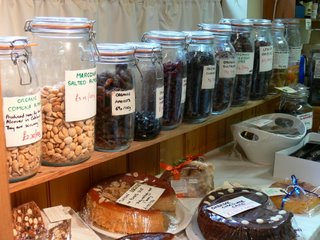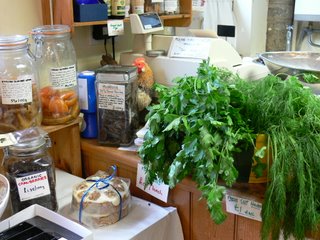 In the last week or so, I’ve had several emails and comments on old posts asking me where to find certain products I’ve mentioned. I thought listing some favourite suppliers here would be more useful than replying in the comments section of each post. So here, in no particular order, are the online suppliers who I find myself using again and again. Most of these companies deliver outside the UK. If you are in the USA, have a look at Amazon, where you’ll find a lot of the ethnic ingredients listed below. (Sadly for those of us on this side of the Atlantic, Amazon in the UK is very slow in catching on to the grocery shopping it offers in the US. I’m hoping they’ll roll out the service soon.)
In the last week or so, I’ve had several emails and comments on old posts asking me where to find certain products I’ve mentioned. I thought listing some favourite suppliers here would be more useful than replying in the comments section of each post. So here, in no particular order, are the online suppliers who I find myself using again and again. Most of these companies deliver outside the UK. If you are in the USA, have a look at Amazon, where you’ll find a lot of the ethnic ingredients listed below. (Sadly for those of us on this side of the Atlantic, Amazon in the UK is very slow in catching on to the grocery shopping it offers in the US. I’m hoping they’ll roll out the service soon.)
Many of the supermarkets in the UK now offer an online delivery service. I prefer to do my own supermarket shopping (and I get much of my fruit and veg from the very good market in Cambridge), but friends who use Ocado (Waitrose’s service) have been delighted. Tesco and Sainsbury’s also offer a similar service, but I find that the quality of the produce at Waitrose is much better, with Sainsbury’s coming in second place.
American ingredients
**Update 08 June 2007**
If you’re looking for American ingredients, check out this post.
Chinese, Thai and other oriental ingredients
The Asian Cookshop is fantastic if you’re living somewhere with no access to good Oriental supermarkets. They stock Mae Ploy curry pastes (my favourite brand), some fresh ingredients including pandang leaves and galangal, bottled sauces which are hard to find even in some Chinese supermarkets, and dried goods. They also carry Bombay Duck, an Indian dried fish which was unaccountably banned by the EU for a few years. It’s legal again now, and if you’ve not tried it, I’d really recommend buying a pack to eat as a garnish with curry. This is where I come for Vietnamese spring roll wrappers, Chinese lily pods and dried mushrooms. There’s even a sushi section. The Asian Cookshop delivers worldwide.
Wholesale spices and other Indian ingredients
Sweetmart, an Indian wholesalers in Bristol, sells a great range of large boxes and bags of whole spices, alongside other Indian ingredients including some excellent curry pastes. They also carry speciality flours made from barley, beans and so forth. Check out the recipe section.
Ambala foods are a great supplier. Their thoughtful range of sweet and savoury nibbles is wide, their service is impeccable (they’ll always deliver within 24 hours, and are always exceptionally friendly and helpful on the telephone if you need to talk to someone in person). Sweets are posted on the same day that they are made. Try the absolutely delicious Ferrari Chevda (a nibbly, salty, spicy mix with puffed rice, cashews, sev and other good things) and the amazing Assorted Sweets box. Ambala delivers worldwide.
 Herbs and spices
Herbs and spices
Seasoned Pioneers carries a vast range of spice blends from all over the world; I always have their Ras-al-Hanout, shrimp paste and tamarind paste in the cupboard. Every major cuisine in the world is represented in their range, and I love their resealable packs. The blends are fantastically imaginative, and the quality of the product is much better than anything you’ll find in those little glass pots at the supermarket. (The opaque packaging helps here too.) Seasoned Pioneers delivers worldwide.
Steenbergs Organic are appallingly, addictively good. The whole range is organic, and they are the first British herb and spice supplier to use the Fairtrade mark. Alongside all this social responsibility, they’ve managed to find an absolute genius to blend their various seasoning mixtures; their Perfect Salt is something I simply can’t manage without. They carry some fascinating and esoteric spices (the person who asked about pink peppercorns should look here). Look out for grains of paradise, a medieval English favourite; sumach (hard to find elsewhere) and white poppy seeds, which I’ve never seen anywhere else. Their recipes are great too. Give your credit card to someone responsible before you click on the link, or, like me, you might find yourself buying nearly everything they sell.
Steenberg’s do deliver worldwide, but if you are not in the UK you will have to contact them to arrange postage.
Flavourings
I’ve not found any British suppliers as good as Patiwizz in France. They sell flower essences which I love for sweets and cakes (there is nothing as good as a violet fondant). The baking essences are listed alongside other flavourings I’ve not dared try – artichoke, sea urchin, lamb… Patiwizz are currently developing an English-language site, but for now you’ll need to be able to read French to order. They deliver worldwide.
Mexican food
I’ve got a soft spot for Mexican food. Mexican ingredients are really hard to find in the UK, but Lupe Pinto’s in Edinburgh is a terrific source. You’ll find ingredients like chipotle chillies in adobo (an delicious ingredient regular readers will notice I use almost to the point of obsession), taco sauces, whole yellow chillies and my Mexican holy grail, canned tomatillos. They stock the hard-to-find chipotle Tabasco sauce, which means I don’t have to import it from America any more. Lupe Pinto’s also carries some American groceries for hungry ex-pats, and a great selection of tequila.
Lupe Pinto’s only delivers to the mainland UK at the moment, but they hope to expand.
Chocolate
The English language is not sufficiently developed yet to allow me to express just precisely how good l’Artisan du Chocolat, based in London, is. I promise that you have never, ever tasted chocolates this good. The prices reflect the quality of the product, but once you’ve got one in your mouth, the chocolates feel like an absolute bargain.
L’Artisan du Chocolat delivers worldwide.
Monday’s post massaged my online shopping gland. For several hours after writing it, I found I wasn’t concentrating properly. My thoughts kept wandering in the direction of squashy, silky, sugary Indian sweets like the ones from Ambala Foods. Eventually I gave in and ordered a 500g box. At £3.90, these boxes are fantastic value, so their purchase won’t weigh heavily on your mind. ( Your hips are another matter.)
Here’s the Motichoor ladoo. It’s a traditional sweet, eaten only at very special occasions, like weddings and festivals. It’s also given as a very special gift. It’s a lovely little mouthful made from little pellets of gram flour, sugar and ghee, which is cooked in a sugary syrup. A little pistachio is sprinkled on top.
Pera (right) is, according to Ambala, a sweet which is loved by children. I love it too – it’s made from sugary curds of milk, flavoured with saffron, and is sweetly silky. Each of these sweets is available to order individually, alongside some other mixed boxes, including one which is full of very lovely, fudgy Barfi.
My favourite Barfi are the plain ones. Their scented flavouring is beautifully put together; the flavour comes from orris root (the root of a highly fragranced iris, which is also used in perfumery) and cardamom seed. This box also contains Barfi with almonds and pistachios, and a slice of amazing carrot Halwa, which is also flavoured with that incredible orris root.
